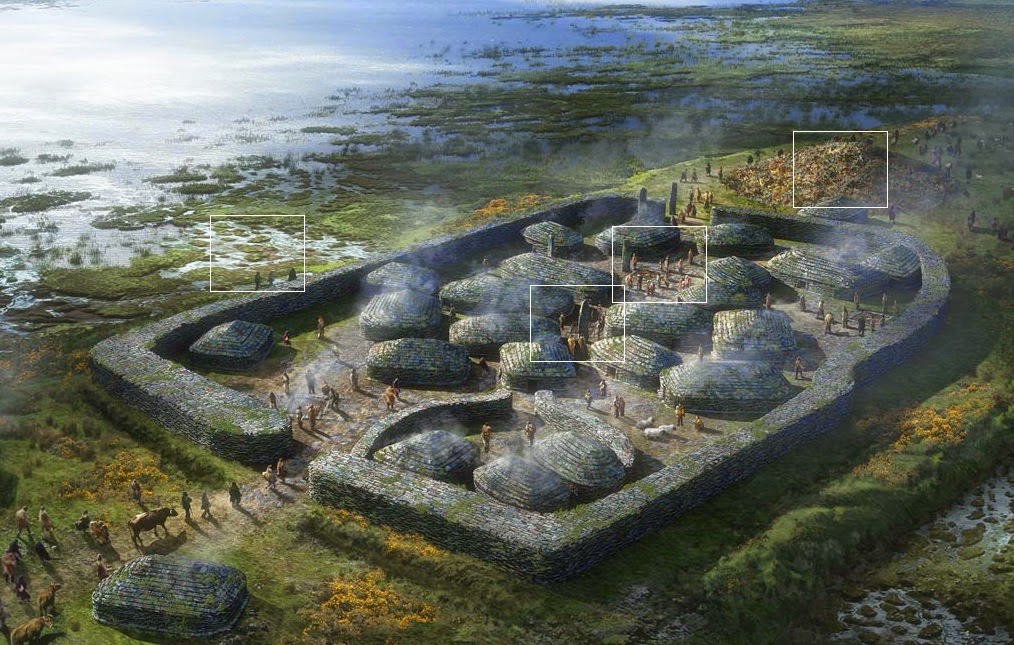There's a nice article, graphic, map and photo gallery featuring the Ness of Brodgar on the National Geographic web site, here:
http://ngm.nationalgeographic.com/2014/08/neolithic-orkney/brodgar-graphic
The article claims that a great complex of buildings and standing stones involved the quarrying and transport of "thousands of tonnes" of sandstone which was transported several miles to the site portrayed in the graphic. But no evidence is given to support that contention.......
From the "Decoded Past" web site:
http://decodedpast.com/neolithic-scotland-heart-orkney-world-heritage-sites/4413
"The Neolithic drive towards impacting and shaping the landscape, which is evident in slightly later sites across Britain and France, probably began with agriculture. The Neolithic people learned how to move and manipulate rocks in order to make fields to grow crops and rock enclosures to keep cattle from straying.
The Stones of Stenness are true megaliths, in that they are about twenty feet tall. The 23 foot passage into Maeshowe is almost completely walled by two massive megaliths laid on their long edges. There may originally have been sixty stones in the perfect circle that is the Ring of Brodgar, although only twenty or so are still evident. Certainly, a large number of people participated in quarrying, moving and erecting the stones."
There's a quote from Neil Oliver's book: “A whale-back ridge dominates the middle of the Brodgar peninsula, roughly halfway between the Ring of Brodgar and the Stones of Stenness, and it had always been taken for a natural feature. The fact that it lies right at the centre of this great natural amphitheatre, containing all of Orkney’s most famous ritual monuments, seemed purely a coincidence of geology.”
The award of World Heritage status in 1999 led to plans for a more thorough investigation of the area surrounding the site. This began in 2002 when a geophysical survey was undertaken across the isthmus that links the stone circles, and then the archaeologists got to work. Annual programmes of digging still continue, but by 2012, archaeologists excavated a massive walled enclosure of a dozen mainly ritual buildings.
Robert McKie reports in his article ‘Neolithic discovery: why Orkney is the centre of ancient Britain’.
The site contains some of the most perfectly constructed stone walling of any historical era that stood for a thousand years from about 3300 BC. In spite of being ritually ‘decommissioned,’ after excavation, it still stands to two metres in height. Anyone crossing between the two stone circles would have to pass through the site, and its buildings are not residential in character.
-------------------------------------------
There does seem to be a vast amount of stone used in these structures. Don't have a problem with that -- if you have a big project and you have little timber available, you will use stone, from wherever you can get it. Much of it will have been quarried or dug up close to the places where it was needed -- indeed the easy availability of stone might have been a determinant for the location of the Ness in the first place. Other stones will have been glacial erratics, and some monoliths might have come from places where they were easy to wedge out of the bedrock exposures.
I get a sense from the newer reports that there is a big difference between the interpretations of Colin Richards, who attaches profound significance to the act of quarrying and profound -- maybe spiritual or ritualistic -- significance to the places where the quarrying was done, and the much more utilitarian interpretations of the current digging teams on Orkney. As far as I can see, they think that the builders of the Ness needed stone, so they went out and got it from wherever they could find it. Nice and simple.

4 comments:
Brian,
An effective way to not answer old questions is to ask new questions. Done in politics all the time!
Didn't Myris say as much in his typical cryptic way way back when?
Kostas
This is archaeoacoustics rather than geology, but I was on Orkney a couple of weeks ago in unusually sunny & windless conditions. The echo inside the Ring of Brodgar has been noted before but I was able to record it clearly on video - also the much shorter echo inside the Stones of Stenness:
http://vimeo.com/100042107
Steve Marshall
To my untrained eye, all of the neolithic structures on Orkney seemed to be just be made of the stone which was available. It naturally breaks into flat sheets which can be piled up easily to form stable dry stone walls. The Ness looked the same as everything else in that regard. While you can imagine the larger monoliths being quarried specially, all of the general building looks entirely utilitarian.
Fascinating place, Orkney, well worth a visit.
It's on my little list -- one day, all being well......
Post a Comment